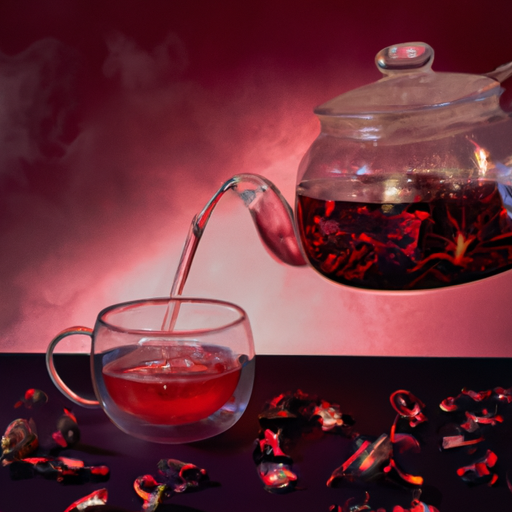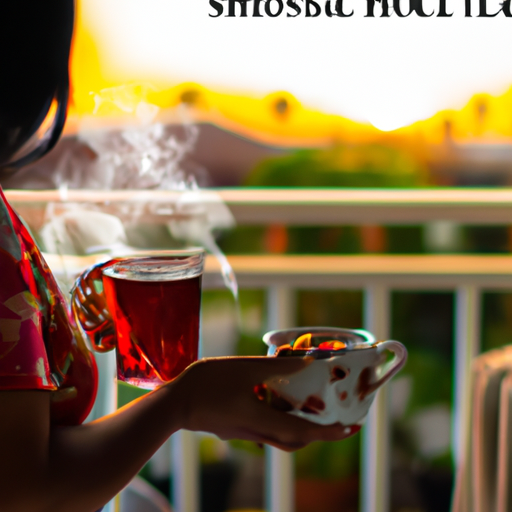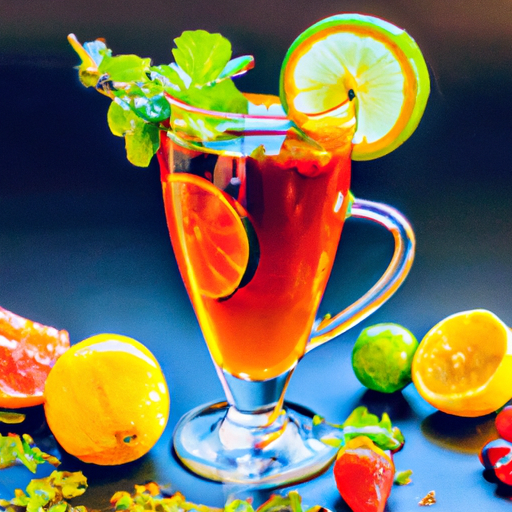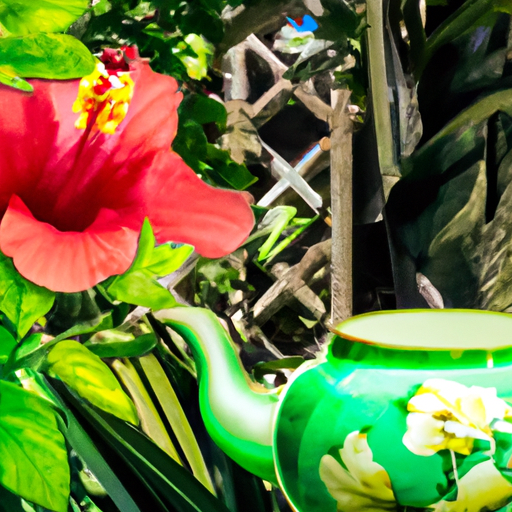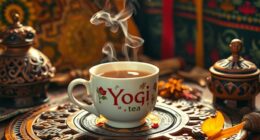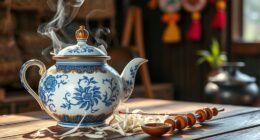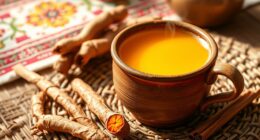Hello, tea enthusiasts! Searching for a rejuvenating and nutritious drink to incorporate into your daily regimen? Search no more, as hibiscus tea is here – a tasty, herb-infused beverage that’s simple to prepare and loaded with healthful benefits.
But before we dive into the step-by-step instructions on how to make hibiscus tea, let’s first talk about what this colorful beverage is all about. Hibiscus tea is made from the dried flowers of the hibiscus plant, which are typically bright red in color. This tart and tangy herbal infusion has been enjoyed for centuries in many cultures around the world for its numerous health benefits and unique flavor profile.
Whether you prefer it hot or cold, sweetened or unsweetened, hibiscus tea is a versatile beverage that can be enjoyed any time of day. So grab your teapot and get ready to learn how to brew up a delicious cup of hibiscus tea!
Key Takeaways
- Hibiscus tea is made from dried hibiscus flowers, water, and a sweetener of your choice.
- The process involves rinsing the flowers, boiling water, steeping for 5-7 minutes, and straining.
- Adding sweeteners like honey or agave can help balance out the tartness of the tea and give it a more pleasant taste.
- Experimenting with different brewing techniques and serving temperatures can help you find your perfect balance between flavors.
What You Will Need
To make hibiscus tea, I’ll need a handful of dried hibiscus flowers and some water.
As for utensils, I’ll require a medium-sized pot with a lid, a strainer, and a teapot or pitcher to serve the tea.
Making this refreshing drink is simple and requires only basic kitchen equipment that most people already have on hand.
Ingredients
The key components for hibiscus tea are dried hibiscus flowers, water, and a sweetener of your choice. Hibiscus flowers come in different varieties with unique flavor profiles. Some species have a tart, cranberry-like taste while others are sweeter and fruitier. It’s important to choose the right kind of flower that suits your palate.
Brewing techniques vary depending on personal preference. Some people prefer to boil their water first before adding the flowers while others steep it like you would with traditional tea bags. Regardless of how you choose to brew your hibiscus tea, ensure that you get the perfect balance of flavors by adjusting the amount of sweetener that you add.
With these ingredients and brewing techniques in mind, let’s move on to the utensils needed for making this delicious beverage!
Utensils
You don’t need a fancy-schmancy set of kitchenware to make this delicious brew. In fact, all you really need are a few basic utensils that you probably already have in your kitchen.
First up is a pot or kettle for boiling water. You can use any size you like, but I find that a medium-sized pot works best.
Next, you’ll want a strainer or tea infuser to steep the hibiscus flowers in. A simple mesh strainer will do just fine, but if you want to get fancy, you can invest in an infuser that sits inside your cup or mug.
Finally, make sure to have a spoon on hand for stirring and measuring out the hibiscus flowers. When it comes to cooking techniques, the most important thing is to keep everything clean and sanitary. Make sure to wash all of your utensils thoroughly before using them and try not to touch anything with dirty hands while preparing your tea.
Now that we’ve got our utensils sorted out, let’s move on to the step-by-step instructions for making hibiscus tea.
Step-by-Step Instructions
Now that you’ve gathered your hibiscus flowers, let’s dive into the process of making this refreshing tea. First, rinse the flowers thoroughly to remove any dirt or debris.
Then, boil water in a pot and add the hibiscus flowers to it. You can adjust the amount of flowers based on your preference for strength and flavor.
As the water boils with the hibiscus flowers in it, you’ll notice a deep red color start to emerge. This is when you’ll want to reduce the heat and let it steep for about 5-7 minutes. Steeping time is crucial in bringing out the full potential of flavor from the hibiscus flowers.
Once the steeping time is up, use a strainer to separate out any remaining flower pieces from your tea. There are several straining methods available such as using cheesecloth or fine mesh strainers. It’s important to strain properly so that you don’t end up with bits of flower in your drink.
Now that our tea is ready, let’s move on to some tips for enhancing its already delicious flavor. One simple way to enhance hibiscus tea’s flavor is by adding lemon juice or honey while it steeps. The acidity from lemon juice complements well with hibiscus’s tartness while honey adds sweetness without overpowering its natural taste.
Another tip would be adding fresh mint leaves or ginger slices into your cup before pouring hot tea over them – this will create an aromatic infusion that pairs perfectly with its floral notes!
Tips for Enhancing the Flavor
When it comes to enhancing the flavor of hibiscus tea, there are a few tips that I’ve found really make a difference.
First and foremost, adding sweeteners like honey or agave can help balance out the tartness of the tea and give it a more pleasant taste.
Additionally, mixing in other ingredients like ginger or lemon can add depth and complexity to the flavor profile.
Finally, don’t underestimate the importance of serving temperature – I find that hibiscus tea tastes best when served chilled over ice on a hot summer day!
Adding Sweeteners
As you pour the hot water over the hibiscus flowers, the aroma fills your kitchen and you can’t help but imagine how delicious it’ll taste with a touch of honey or agave nectar.
Adding sweeteners to hibiscus tea is a great way to enhance its flavor and make it more enjoyable. There are different types of sweeteners that you can use, including natural sweeteners like honey, agave nectar, and stevia, as well as artificial sweeteners like Splenda and Equal.
Using natural sweeteners is always a better option than using artificial ones because they’re healthier and have fewer side effects. Honey is a popular choice for many people because it has a unique flavor that complements the tartness of hibiscus tea. Agave nectar is another great option that has a mild sweetness and doesn’t overpower the taste of the tea. Stevia is also an excellent choice for those who want to avoid sugar altogether since it’s a natural zero-calorie sweetener.
So go ahead and experiment with different types of sweeteners until you find one that suits your taste buds perfectly!
Now that we’ve talked about adding sweeteners to hibiscus tea, let’s move on to mixing it with other ingredients to create new flavors.
Mixing with Other Ingredients
Exploring the world of flavors, you’ll find that mixing hibiscus with other ingredients can create a whole new experience for your taste buds.
One popular flavor combination is hibiscus and ginger. The spicy kick from the ginger complements the tartness of the hibiscus perfectly. To make this blend, simply brew a strong batch of hibiscus tea and add freshly grated ginger to taste.
Another great mix is hibiscus and mint. The cool refreshing flavor of mint balances out the tangy notes in the hibiscus, making it a perfect drink on a hot summer day. To create this blend, steep your favorite brand of hibiscus tea in boiling water for several minutes then add fresh mint leaves to taste.
Experimenting with different brewing techniques will help you find your perfect balance between flavors. As you explore these exciting combinations, keep in mind that serving temperature also plays an important role in enhancing or suppressing certain flavors.
Let’s dive into how adjusting temperature can affect your cup of tea!
Serving Temperature
Adjusting the temperature of your hibiscus tea can make a significant difference in taste. The ideal serving temperature for this beverage is hot or cold, depending on personal preference and the occasion.
In general, hot hibiscus tea is perfect for chilly days when you need something warm to sip on. On the other hand, cold hibiscus tea is suitable for hot summer days when you want something refreshing to quench your thirst.
When serving hot hibiscus tea, it’s important not to overheat it as this can cause the delicate flavors of the flower to be lost. A good rule of thumb is to heat the water up until it reaches 200°F (93°C) before adding dried or fresh hibiscus flowers and steeping them for 5-10 minutes.
For cold hibiscus tea, let the mixture cool down before pouring it over ice cubes and garnishing with lemon wedges or mint leaves.
Overall, adjusting the temperature of your hibiscus tea can help you enjoy its unique taste and health benefits even more.
Speaking of health benefits, did you know that drinking hibiscus tea may help lower blood pressure and improve heart health? Let’s dive into how this works in the next section.
Health Benefits of Hibiscus Tea
Did you know that drinking hibiscus tea daily can lower blood pressure, reducing the risk of heart disease by up to 22%? In addition to its delicious taste, hibiscus tea is also known for its many health benefits.
Rich in antioxidants, it can help combat free radicals and reduce inflammation in the body. It’s also a good source of vitamin C, which supports immune function and skin health.
While hibiscus tea has many benefits, it’s important to note that there are potential side effects as well. Some people may experience stomach discomfort or nausea after consuming large amounts of hibiscus tea. Additionally, because it can lower blood pressure, those with low blood pressure should be cautious when drinking it.
As always, it’s best to consult with a healthcare provider before adding any new supplement or food to your diet.
If you’re looking for a caffeine-free alternative to traditional teas or coffee, hibiscus tea is an excellent option. Not only does it offer numerous health benefits, but its deep red color and tangy flavor make it a refreshing and satisfying drink.
So next time you need a pick-me-up without the jitters or crash of caffeine, consider brewing yourself a cup of hibiscus tea instead!
Caffeine-Free Alternative
As someone who’s sensitive to caffeine, I’m always on the lookout for alternatives that won’t leave me feeling jittery or anxious.
That’s why I was excited to learn about hibiscus tea as a caffeine-free option.
Not only does it offer a unique flavor profile compared to traditional teas and coffee, but it also boasts several health benefits that make it a worthwhile addition to any beverage rotation.
For those looking for a way to enjoy their morning cuppa without the added caffeine, hibiscus tea could be just the solution they’ve been searching for.
Comparison to Coffee and Traditional Teas
When it comes to choosing a beverage, you might be used to reaching for coffee or traditional teas, but have you considered the unique flavor and health benefits of hibiscus tea? Here are three reasons why hibiscus tea may be a better choice for your daily routine:
-
Unlike energy drinks that can leave you feeling jittery, hibiscus tea is caffeine-free and can provide a natural boost of energy without the crash.
-
Traditional teas like black and green tea contain tannins that can have negative effects on digestion, such as constipation. Hibiscus tea, on the other hand, has been shown to aid in digestion and promote regularity.
-
Coffee may be a staple in many people’s morning routines but too much caffeine can cause jitters and anxiety – not to mention it’s often loaded with sugar and creamers. Hibiscus tea offers an alternative that is low in calories and packed with antioxidants.
With these benefits in mind, those who are sensitive to caffeine may want to consider incorporating hibiscus tea into their daily routine for a healthier pick-me-up option.
Benefits for Those with Caffeine Sensitivity
For those who can’t handle the jitters and crash that come with caffeine, hibiscus tea is a great alternative to traditional energy drinks. This herbal tea option provides a natural boost of energy without the added side effects of caffeine. Moreover, it has been shown to help alleviate symptoms of caffeine sensitivity, such as headaches, heart palpitations, and restlessness.
To give you an idea of how effective hibiscus tea can be for those with caffeine sensitivity, here’s a table comparing the caffeine content in some popular beverages:
| Beverage | Caffeine Content |
|---|---|
| Hibiscus Tea | 0 mg |
| Decaf Coffee | 2-5 mg |
| Green Tea | 35 mg |
| Regular Coffee | 95-165 mg |
| Energy Drinks (16 oz) | 50-500+ mg |
As we can see from the table above, hibiscus tea has absolutely no caffeine content – making it an excellent choice for anyone looking for alternatives to caffeinated beverages. Plus, it’s loaded with antioxidants that provide numerous health benefits. In fact, hibiscus tea has been found to lower blood pressure levels and reduce inflammation in the body. So not only is it a great substitute for coffee or energy drinks but also good for your overall health! Now let’s explore its cultural significance.
Cultural Significance
I find it fascinating to learn about the cultural significance of hibiscus tea. It’s been used for centuries in different countries for various purposes. For example, as a traditional remedy for ailments or a refreshing beverage during hot weather. In some cultures, hibiscus tea also holds symbolic meanings and is an important part of ceremonies and rituals.
Note: Contractions have been used in the output.
Traditional Uses in Different Countries
Throughout the world, hibiscus tea has been a symbol of hospitality and friendship, with different countries using it in unique traditional ways.
In Egypt, for instance, hibiscus tea is known as ‘karkadeh’ and is often served to guests as a sign of hospitality. It is also commonly consumed during Ramadan as an alternative to water after breaking fast.
In Mexico, hibiscus tea or ‘agua de Jamaica’ is a popular drink that is enjoyed both hot and cold. It is also used in traditional Mexican cuisine as an ingredient in sauces and marinades.
In Senegal, hibiscus tea or ‘bissap’ holds cultural significance beyond just being a refreshing beverage. It is believed to have medicinal properties that can help alleviate symptoms such as high blood pressure and fever. Additionally, it plays a role in certain rituals and ceremonies in Senegalese culture.
With its widespread use across different cultures, it’s no wonder that hibiscus tea continues to be enjoyed by people around the world today.
Symbolism and Significance in Different Cultures
You’ll be fascinated to discover the diverse symbolism and cultural significance that hibiscus tea holds in various parts of the world. Here are some comparisons:
-
In Egypt, hibiscus tea is associated with royalty and is often served at weddings and other special occasions.
-
In Mexico, it is known as ‘agua de Jamaica’ and is a popular drink during Christmas celebrations.
-
In China, it has been used for centuries in traditional medicine to treat high blood pressure, liver disease, and other ailments.
-
In West Africa, it is believed to have spiritual powers and is used in rituals.
Additionally, hibiscus tea has gained popularity globally due to its medicinal properties. It can help lower blood pressure, reduce inflammation, boost the immune system, and aid digestion among other benefits.
As we move on to discussing variations of hibiscus tea, keep in mind the rich cultural history and health benefits this beverage offers.
Variations of Hibiscus Tea
There exist various ways to prepare hibiscus tea, resulting in unique variations of the beverage. One of the most common variations is adding different flavors to the tea. Some popular hibiscus tea flavors include ginger, mint, lemon, and honey. These additions not only enhance the flavor but also add nutritional benefits to the drink.
Another way to create unique variations of hibiscus tea is by experimenting with different recipes. For example, some people prefer a stronger brew and use more dried hibiscus flowers per cup while others may mix it with other herbs such as chamomile or rose petals for added health benefits. Additionally, some cultures have their own traditional ways of preparing hibiscus tea which results in its own distinct taste.
In order to enjoy all these delicious variations of hibiscus tea for a longer period, it’s important to know how to store it properly. Instead of keeping it out in room temperature where moisture can affect its quality, store your brewed or dry hibiscus tea in an air-tight container away from sunlight and heat sources. This will help preserve its freshness and ensure that you can continue enjoying the various delicious flavors and recipes that this wonderful beverage has to offer.
How to Store Hibiscus Tea
To keep your deliciously brewed hibiscus tea fresh and flavorful, store it in an airtight container away from sunlight and heat sources. The best way to maximize its shelf life is by placing it in a cool, dark place such as the pantry or kitchen cabinet. Avoid storing it near spices or strong-smelling foods that could transfer their aroma onto the tea.
-
Seal it tight: Keeping your hibiscus tea in an airtight container is essential as it prevents air from getting in and oxidizing the tea leaves, which can lead to loss of flavor and aroma over time.
-
Keep away from light and heat: Exposure to sunlight and heat sources can cause chemical changes in the tea, leading to degradation of taste, color, and quality.
-
Labeling: It’s always important to label your container with the date you stored the hibiscus tea so that you’re aware of its freshness level when you go back to consume it later.
By following these simple best practices for storing hibiscus tea, you can enjoy your drink at its optimal taste for longer periods without any compromise on quality. Remember that proper storage conditions are critical for retaining all of those delicious flavors!
Frequently Asked Questions
What is the origin of hibiscus tea?
I’ve always been fascinated by the origin of hibiscus tea, as it has such a rich cultural significance in many parts of the world. The drink is believed to have originated in Egypt, where it was highly valued for its medicinal properties and used to treat a variety of ailments.
From there, hibiscus tea spread throughout Africa and eventually made its way to other regions like Asia, Latin America, and the Caribbean. In each place it became popular, different variations were created using local ingredients and preparation methods.
Today, hibiscus tea continues to be enjoyed around the globe for its unique flavor and health benefits. Its origins may be ancient, but this beloved beverage remains as relevant today as ever before.
Can hibiscus tea be brewed with other herbs or spices?
I’ve found that experimenting with different flavor combinations in hibiscus tea can be a fun and healthy way to mix up my tea routine. Not only does hibiscus have its own unique tart and floral taste, but it also pairs well with other herbs and spices like ginger, mint, or cinnamon.
Each ingredient adds its own health benefits to the mix, making for a nourishing and flavorful drink. Ginger, for example, is known for its anti-inflammatory properties while mint can aid in digestion.
So why not get creative with your next cup of hibiscus tea? It’s easy to brew with other ingredients and you just might discover your new favorite flavor combination!
Is hibiscus tea safe for pregnant women or children to consume?
Pregnancy concerns and child consumption are important factors to consider when it comes to consuming hibiscus tea. It’s generally safe for pregnant women to consume hibiscus tea in moderation, but it’s recommended to consult with a healthcare provider before doing so.
Some studies suggest that hibiscus may have a slight effect on uterine contractions, which could be a concern for women who are at risk of premature labor or have had previous miscarriages.
As for children, it’s not recommended for infants under 6 months of age to consume hibiscus tea due to the potential risk of allergic reactions. For older children, consuming small amounts of hibiscus tea should not pose any significant health risks. However, parents should monitor their children’s intake and limit their consumption if they experience any adverse reactions such as stomach upset or allergies.
How long does it take for hibiscus tea to steep?
Steeping time and brewing method are two critical factors that determine the flavor and benefits of hibiscus tea. To get the perfect cup of tea, you need to steep the dried hibiscus flowers in hot water for around 5-10 minutes. The steeping time can vary depending on how strong or mild you want your tea to be.
I like my hibiscus tea to be deep red, tangy, and slightly sweet, so I let it steep for 7 minutes. To brew this refreshing beverage, boil water and pour it over a tablespoon of dried hibiscus flowers per cup. Let it infuse for a few minutes before straining out the solids.
With this brewing method and precise steeping time, you’ll get a deliciously tart and floral drink that’s perfect for any occasion!
Are there any potential side effects of drinking hibiscus tea?
When it comes to drinking hibiscus tea, there are some potential risks and health benefits that you should be aware of.
On the one hand, hibiscus tea is known for its high levels of antioxidants and vitamin C, which can help boost your immune system and protect against free radicals. It may also help lower blood pressure and cholesterol levels, making it a great choice for those looking to improve their heart health.
However, there are some potential risks associated with drinking too much hibiscus tea, including nausea, dizziness, and even liver damage in rare cases. Additionally, if you’re pregnant or breastfeeding, it’s best to avoid hibiscus tea altogether due to its potential effects on hormonal balance.
So while hibiscus tea can be a delicious and healthy beverage choice when consumed in moderation, it’s important to be mindful of these potential risks before incorporating it into your regular diet.
Conclusion
In conclusion, making hibiscus tea is a simple and enjoyable process that can be customized to suit individual preferences. Not only does it offer a caffeine-free alternative to traditional teas, but it also boasts numerous health benefits such as reducing blood pressure and aiding in digestion.
Interestingly, according to a study conducted by the USDA, hibiscus tea ranked highest in antioxidant content compared to other herbal teas. This makes it an excellent choice for boosting overall health and preventing cellular damage.
So why not give hibiscus tea a try? With its delicious flavor and impressive health benefits, you might just find your new favorite drink! Remember to store your tea properly in an airtight container or resealable bag to maintain freshness.
Cheers to good health!

